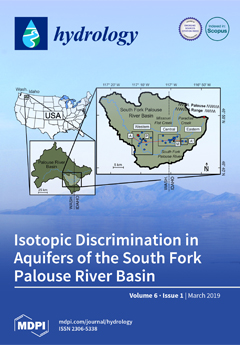Kuttara Volcano, Hokkaido, Japan, consists of temperate Lake Kuttara and the western Noboribetsu geothermal area. In order to explore geothermal relations between Lake Kuttara and the geothermal area, the heat budget of a hydrothermal pond, Okunoyu, was evaluated, and the heat storage change
[...] Read more.
Kuttara Volcano, Hokkaido, Japan, consists of temperate Lake Kuttara and the western Noboribetsu geothermal area. In order to explore geothermal relations between Lake Kuttara and the geothermal area, the heat budget of a hydrothermal pond, Okunoyu, was evaluated, and the heat storage change in the lower layer of Lake Kuttara was calculated by monitoring the water temperature at the deepest point. The lake water temperature consistently increased during the thermal stratification in June–November of 2013–2016. The heat flux
QB at lake bottom was then calculated at a range of 4.1–10.9 W/m
2, which is probably due to the leakage from a hydrothermal reservoir below the lake bottom. Meanwhile, the heat flux
HGin by geothermal groundwater input in Okunoyu was evaluated at 3.5–8.5 kW/m
2, which is rapidly supplied through faults from underlying hydrothermal reservoirs. With a time lag of 5 months to monthly mean
QB values in Lake Kuttara, the correlation with monthly mean
HGin in Okunoyu was significant (
R2 = 0.586;
p < 0.01). Applying Darcy’s law to the leakage from the hydrothermal reservoir at 260–310 m below the lake bottom, the time needed for groundwater’s passage through the media 260–310 m thick was evaluated at 148–149 days (ca. 5 months). These findings suggest that the hydrothermal reservoir below lake bottom and the underlying hydrothermal reservoirs in the western geothermal area are both connected to a unique geothermal source in the deeper zone as a geothermal flow system of Kuttara Volcano.
Full article





